Hazelnut and Apple Potato Skins

You know when you’re staring round your kitchen, trying to come up with anything to eat to ring the changes from egg on toast, but nothing that requires more than 10 minutes thought because anything hard can get in the bin!? Yes? Probably. I think we’ve all had days like that. Well, that was me a couple of days ago and it happened to coincide with a desperate need to go shopping (the horror!).
Let me set the scene.
What do we have? Eggs? No. Not again. I love you eggs, but three days for both lunch and dinner is too much.
Potatoes! Excellent. Now, what to do with them? Oh well, bung ‘em in to bake while you decide. There must be something.
Potatoes are done!
And there’s… nothing. Beans? No. Tuna? No. Leftovers? If we had those, why would we be panicking? How did this happen!?!? Laziness.
WELL WHAT DO WE HAVE???
Eggs.
NO!!!
In total? Some roast diced hazelnuts, a couple of apples that need using up… oh! And cheese. Cheesy baked potato it is! We’re saved!
Give me a minute!
…
…
OK, so here’s what we’re going to do...
All of that was just me, by the way. I am not that aggressive with my family, promise. So, as you can see things were a bit less than ideal, but something incredible came out of it.
Wanting something a bit more exciting than cheesy baked potato (although it has served me very well over the years) or just because I was feeling awkward, I decided to experiment (there were always eggs as a back-up) and something incredible was born. Filled potato skins with hazelnuts, apple and cheese.
It’s salty, sweet, nutty, filling, potato goodness. You can eat it with your hands, which is perfect for Bonfire Night, if you are going to treat this dish with the respect it deserves, rather than the hunger-panic that induced it. I mean… it’s potato skins. They’re never bad. But these are excellent. After everyone was persuaded to try them, repeat orders were put in immediately.
Seriously. These are good.
And they are vegetarian!
Quantities vary according to how many you are making, so the instructions will be a bit vague (hunger-panic, remember)
- Peel 1 apple and dice into very small pieces. Throw in a bowl along with a handful of diced roasted hazelnuts and cheese.
- Cut your baked potato(es) in half and scoop out the insides, putting the scooped potato in the bowl with the other ingredients.
- Mash everything together with a fork. Take a handful (or spoonful, if you are feeling fancy) and shove it back into the potato skin. Repeat until all skins are filled.
- Bake at 180°C for 20 minutes.
- Serve!
Pair with
Mango Frapple. I grabbed it and it went really well. The taste fairies were on my side
Bonfire Night Parkin with a Gin, Ginger and Lime Cocktail
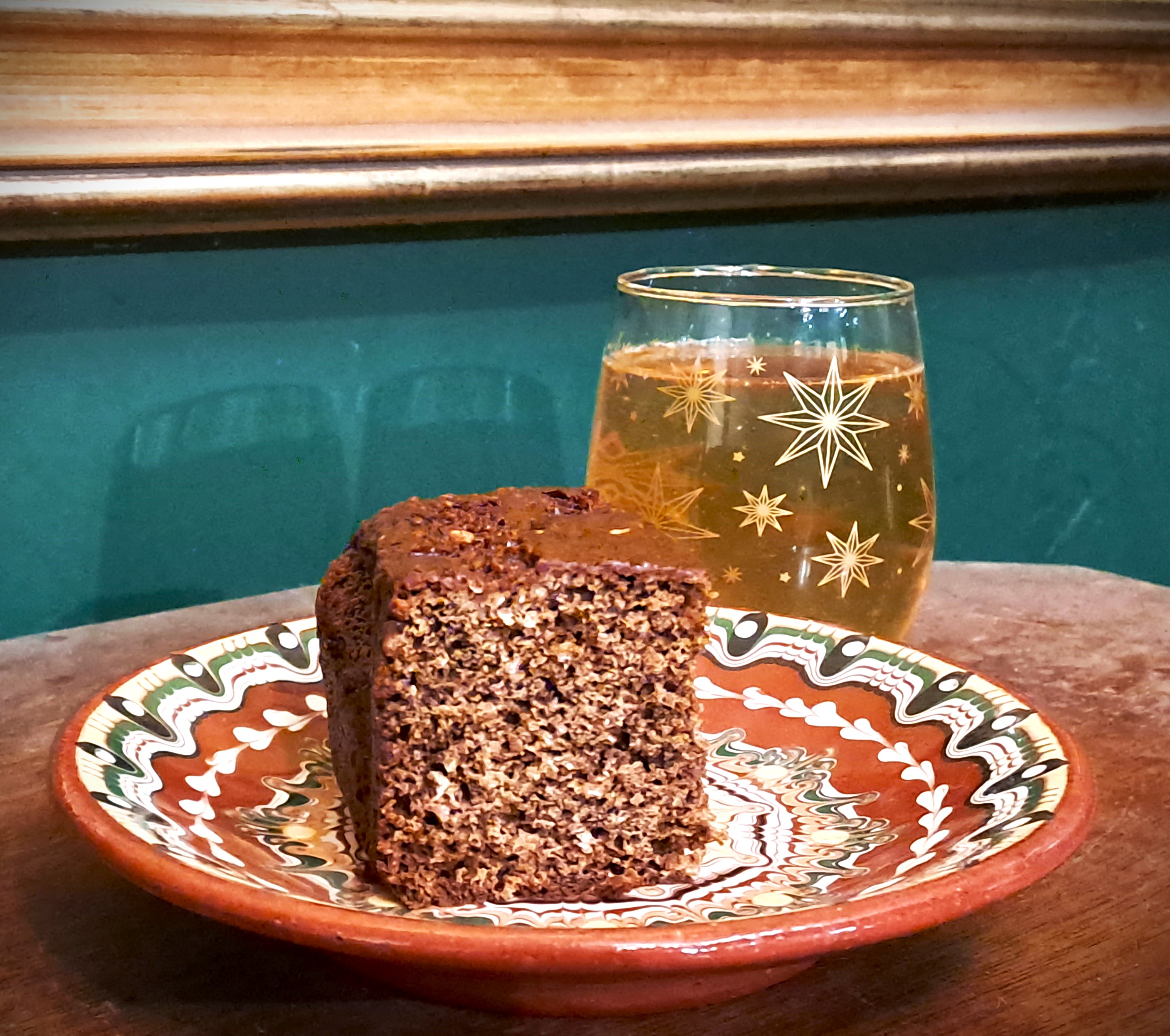
Does anyone else find that the run-up Bonfire Night smells amazing? I don’t know if it’s just around my house, but there always seems to be a smell of bonfires (possibly obviously, but there never seems to be one on the go) spice and leaves cutting through the air.
My dogs bullied me into taking them for their bedtime walk in the pouring rain and even then, the air was filled with that gunpowder smell which never seems to be around at any other time of the year.
For me, that smell is very comforting, even if it does mean I will shortly have to reassure my big bad wolf that the big bangs are not trying to kill him (please be pet aware when using fireworks). That October/November aroma is a consistency that has always come back every year and wrapped me up, letting me know that the year is tipping into the build-up for Christmas and all the joy that brings.
When that scent descends on the valley, it feels like the world telling me it’s time to go into hibernation. That everything is safe and will be all right when I wake up.
Unfortunately, no matter how magnificent a blanket tower I make, I have yet to achieve human hibernation (although not for lack of trying), so to do homage to my favourite smell, I made a Parkin, with a Gin, Ginger and Lime cocktail.
I was reading a recipe book of regional cakes and it mentioned a Grasmere Gingerbread, which included lime to cut through the ginger. Since there was already a Parkin in the house and I have been instructed by my family that I can ‘only bake one cake at a time or there will be consequences’, I decided to try a cocktail version of this idea and it holds up incredibly well. The lime adds a freshness to the ginger and really brings out the botanicals in The Exe Gin beautifully.
Parkin Recipe
- 225g plain flour
- 3 tsp ground ginger
- 1tsp mixed spice
- ½ tsp bicarbonate of soda
- 1 pinch of salt
- 125g medium oatmeal (or same amount porridge oats pulsed in the food processor for a minute)
- Zest of 1 large orange (finely grated)
- 125g butter
- 125g light brown sugar
- 3 tbsp golden syrup
- 1 tbsp molasses or treacle
- 75ml milk
- 1 egg, beaten
- Preheat the oven to 180°C and grease and line a 20cm square cake tin.
- Heat the butter, sugar, golden syrup, molasses, and milk in a saucepan over a low heat, stirring occasionally until the butter is melted and the sugar is fully dissolved. Set aside to cool.
- Sift the flour, ginger, mixed spice, bicarbonate of soda and salt into a large bowl, then stir in the oatmeal and orange zest.
- Add the beaten egg to the met ingredients and mix in.
- Make a well in the centre of the dry ingredients and pour in the syrup mix. Stir together until the mixture is smooth.
- Pour the mix into the prepared tin and shake the tin to make sure that the batter is evenly spread.
- Cover with tin foil and bake for 35-40 minutes, then remove the foil and bake for another 20 minutes. Remove when a skewer comes out clean.
- Leave to cool in the tin and then remove and wrap in greaseproof paper. You should leave this to cake to mature for a week for maximum flavour, but patience and cake do not mix well, so rest assured that it tastes good whenever you eat it. If you do possess the gift of patience, this cake will keep for up to 4 weeks if you keep it in an airtight container.
Pair with
I’m not going to give quantities here, because everyone likes their cocktails a little different, in my experience (except Cosmos… then my way is the only way), in terms of strength, or what flavour they want to be dominant. I prefer things sourer than my mum, for example.
The ingredients for this recipe are simple, though.
- The Exe Gin https://courtneys.online/gin/the-exe-gin/
- Ginger Wine
- Lime Juice
- Soda Water
Have fun!
Cézanne and Apples
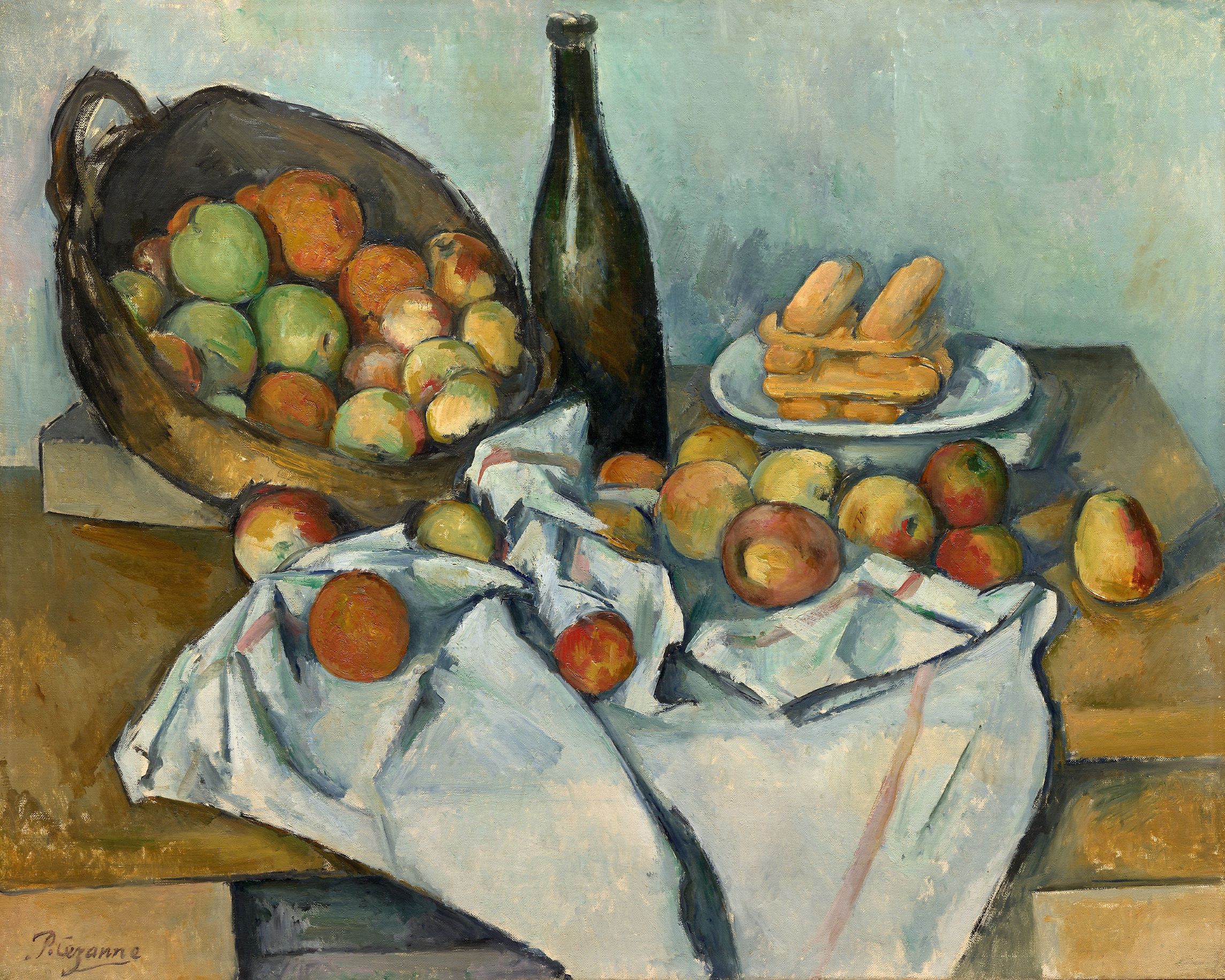
Paul Cézanne (1839-1906) is often credited as the artist who served as the transition from 19th century style painting to more radical 20th century styles. That is an incredibly sweeping statement with boatloads of nuance missing, but it serves as a good ta-da opener, so I’ll quote it anyway.
Cézanne is mainly credited with influencing early Cubism, invented by Picasso and Braque around 1906-07. Cézanne didn’t directly take part in this movement (he is not a Cubist), but the basic idea that Picasso masterfully built on was the concept of taking a three dimensional object or image and presenting it on a two dimensional plane, which Cézanne often explored in his later works.
As was the habit for most 19th century artists in Paris, Cézanne often visited the Salons and Galleries to study the Old Masters – as artists before 1800 were collectively known. Through studying the Old Masters, their subject matter and techniques, Cézanne created a bridge between the old and the new/yet to be invented. Cézanne took on traditional subject matter, traditional composition, and applied new techniques to these subjects.
Let’s look at Cézanne's ‘Basket of Apples’ (1893) as an example.
Paintings of still lives were popular in 17th century Northern Europe (mainly the Netherlands), where post-Reformation laws made it difficult for artists to paint religious scenes or scenes containing religious (Catholic) imagery. Still life subjects allowed artists to showcase their technique, perspective and artistic eye. The most important thing in 17th century still lives was verisimilitude: the painting’s audience should feel that they could reach into the painting and feel the texture of the petals of the flowers in a vase; feel the slipperiness of the fish on a slab; grab the apple from a bowl and take a bite.
When neo-classicism came into style in the 18th century and brought with it a fascination for Roman and Greek styles and interests, the still life was relegated to a lower art form (literally) and forgotten, in favour of now possible religious, historic or contemporary subject matter.
Because so few artists were interested in Still Life, this gave a ‘blank canvas’ for Cezanne and innovation.
Fine Art, since the 15th century in Italy (I’ve seen a lot of very compelling arguments for earlier dates, but can’t find my notes now, so am going with the general consensus) had been based on the use of single-point perspective – the idea that things get smaller the further away they are, eventually resulting in a vanishing point. This created depth, three-dimensionality, realism: all the things that artists had been chasing since the Romanesque period.
Verisimilitude was not Cezanne’s objective.
Cezanne took the concept of the still life, but painted the subject with disjointed perspective. Rather than viewing a static object at a single moment in time, Cezanne painted it as a human seeing the scene from multiple places at once in a single frame. This leads to some compositional anomalies: the angle of the bottle, the tilt of the basket, the fall of the shadows, the foreshortening of the tablecloth. They are painted from multiple perspectives at once and we can never quite be sure where the individual objects are in relation to one another.
Cezanne also experimented with stripping the scene back to the barest essentials to communicate the image. Red and green circles clearly portray apples, even without the exhaustive detail of, say, Caravaggio or Rembrandt. Through our own associations and knowledge of the composition, our brains fill in the basic information Cezanne has given us, to complete the image of a basket of apples spilling over the table.
Because of these changes in technique, Cezanne is called the Father of Modern Art. His flattening, multi-perspective experiment directly influenced Picasso and Braque in their creation of Cubism and catapulted 20th century fine art into a new dimension. His interest in stripping images back to their barest shapes and colour, devoid of projected context could be argued to have led to the Expressionist movement.
Cezanne and his little bowl of apples on a rainy day did quite a lot, really.
Pub Quiz

Pub Quiz
- Where did the tradition of Apple Bobbing originate?
- America
- Rome
- Britain
- Brazil
- What percentage of apples grown in the UK are used for cider making?
- 26%
- 36%
- 46%
- 56%
- Does rum get drier with age or sweeter?
- Drier
- Sweeter
- What country has the highest per capita gin consumption?
- England
- Malaysia
- Holland
- The Philippines
(Answer: b. Rome. Apple Bobbing was a courting ritual during the celebrations to the goddess Pomona at the end of October. If two youths bit the same apple, they were destined to have a long and fruitful marriage)
(Answer: d. 56%)
(Answer: b. Sweeter)
(Answer: d. The Philippines. Apparently they consume 25 million cases of gin annually)
Apple Meringue Pie
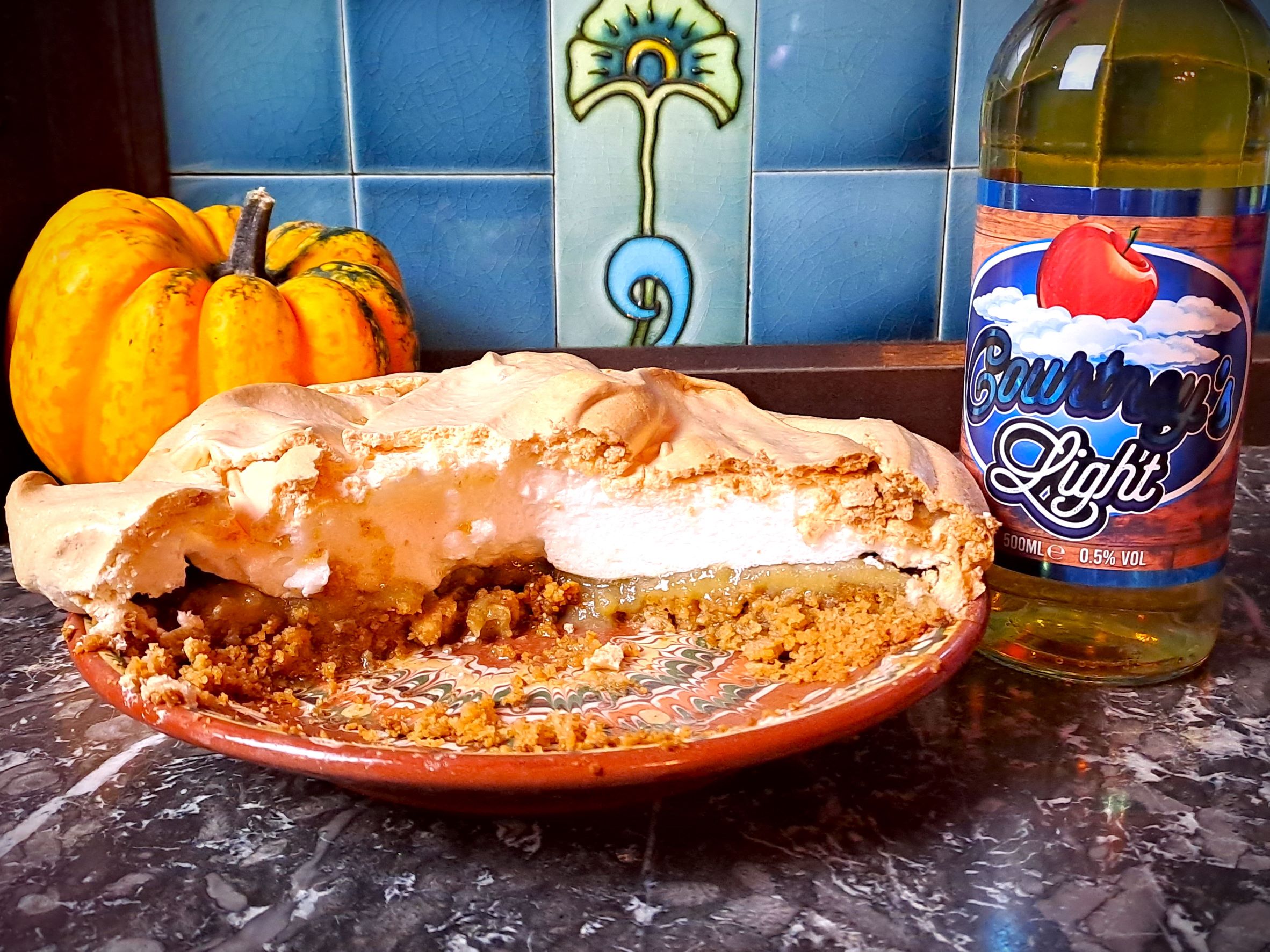
I really wish I could take credit for this recipe. I really, really do. Unfortunately, my mum gets all the credit. She is gifted at picking up seemingly random things and making magic. In this instance, she made a nut butter, crumbly base, which makes this dessert creamy, sweet, tart, earthy, smooth, crunchy, light and filling – in other words, a perfect combination.
Anyway, I’ve stolen it! I present to you the fruits of my crime.
Base
- 300 grammes of digestive biscuits crumbed
- Either 250 grammes of hazelnut butter or 200 grammes of toasted hazelnuts ground finely + 50ml of sunflower/hazelnut oil
- Extra (sunflower) oil if needed
Filling
- 100 to 150 grammes Apple Curd (https://courtneys.online/apple-and-rum-curd/)
- Sliced tart apple (bramley or granny smith) optional
Meringue
- Ratio 1 egg white to 50 grammes granulated or caster sugar
Method
- Heat your oven to 190 degrees C
- Make base – mix together biscuit crumbs and hazelnut cream (or biscuit crumbs, finely ground hazlenuts and oil)
- If the mixture does not hold together, add more oil incrementally. You will use your hands to press the mixture into your base, so the mixture can be crumbly.
- If you are using a plate, make sure it is over proof. Or use a pie tin which is not too deep.
- Press the biscuit and nut mixture into the base
- Cover the base with the apple curd
- Arrange the sliced apple over the apple butter (if using)
- Make the meringue: beat the egg whites to soft peaks. Add the sugar a spoon at a time and beat in until smooth. The meringue should hold its shape and be shiny once all the sugar has been added.
- Cover the pie with the meringue and pile into an artistic mound.
- Bake in the pre-heated oven for 45 minutes.
- Leave to cool and serve.
Serving suggestions
Serve with Courtney’s Light Cider
Apple-o'-Lanterns
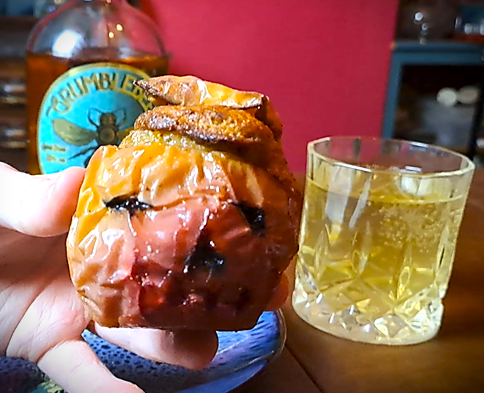
Makes 4 filled apples and 16 cupcakes
Happy Halloween everyone!
The weather has turned and it is time for sweet, dense desserts, that will warm you to your toes, so that you will be prepared for all the spooky events.
I present to you a double recipe of gooey stuffed baked apples (they’re like steamed puddings in an apple) and pumpkin-apple cupcakes, with an extra recipe (because I’m extra nice) for Grumblebee Honey Spiced Rum Caramel!
Muffin Recipe
- 4 apples
- 300g flour
- 300g sugar
- 1 tsp bicarbonate of soda
- 1 tsp ground cinnamon
- ½ tsp ginger
- ¼ tsp ground nutmeg
- ½ tsp salt
- 2 eggs
- 300g cup pumpkin puree
- 120ml sunflower oil
- 75g cup grated apple (peeled and cored)
Method
- Preheat oven to 180°C
- Chop the tops off the apples and core them, making a cupcake sized indent.
- If you want to, carve out a jack-o-lantern face into the apple, being sure not to go all the way through to the hollow.
- Combine and sift the dry ingredients.
- Combine the eggs, pumpkin, oil and apples and blend them together.
- Preheat air fryer to 180°C.
- Mix the dry ingredients to the wet and mix until smooth.
- Spoon the batter into the pre-prepared apples and place the ‘lids’ of the apples over the mixture.
- Place the apples in the air fryer and cook for 20 minutes. I did test this in a standard oven, but it didn’t work at all. The cake batter stayed raw, even after 40 minutes.
- Fill lined cupcake tin with the rest of the batter and bake for 20-25 minutes.
- Remove from the appliances. If you have carved faces into your apples, you can emphasise the look with some food colouring on the tip of a toothpick. Paint in the carved features for a truly spooky look.
- Serve the whole apples warm with rum caramel (recipe below) and ice cream. Allow the muffins to cool and serve with rum caramel (recipe below)
Rum Caramel
- 200g sugar
- 5 tbsp Grumblebee Honey Spiced Rum
- 230ml cream (room temperature)
- 85g butter (cubed and room temperature)
- ½ tsp sea salt
- 1 tsp vanilla extract
Method
- Put the sugar and rum in a heavy bottomed pan and stir over high heat until it is melted. Brush down the pan with water regularly to prevent burning. Stir occasionally.
- When the sugar, rum mix has caramelised into a deep gold colour, add the cream. This will make the mixture bubble violently, so be careful and mix vigorously.
- As soon as the cream has been combined, add the cubed butter and mix in.
- As soon as the butter is melted, remove the pan from heat and add salt and vanilla. Mix.
- Serve.
Serving Suggestions
Grumblebee Honey Spiced Rum and Ginger Ale.
A Potted History of Halloween and Apples
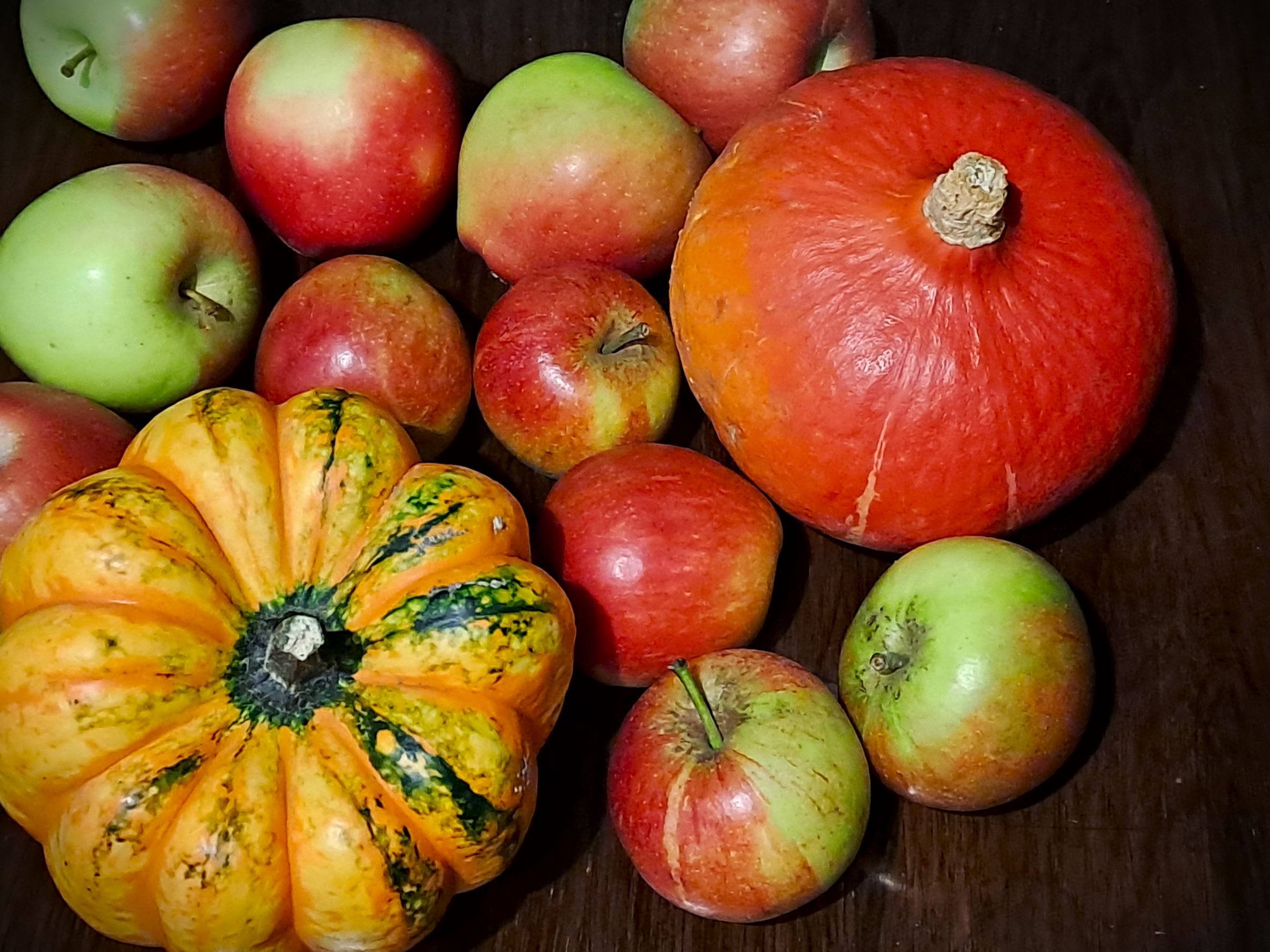
The interesting thing about certain events or associations is that sometimes, just sometimes, everything conspires to make all events inevitable. In Aristotelian tragedy there is always a point of no return, where the protagonist makes their choice and from there on in there is only one possible outcome. All plot points lead to a single outcome. Oedipus kills his father and his downfall is determined. When Macbeth kills the king, there will be no good outcome. When Manon decides to abandon her journey to the convent, there is only one path left for her.
The association of apples with Halloween is perhaps less dramatic, but certainly seems to be fate conspiring for a single scenario: toffee apples and apple bobbing.
As long ago as 400BC, there is evidence that people would put out apples and nuts at the turning of the season to feed the spirits. This was to celebrate the Celtic/Gaelic festival of Samhain, marking the end of the harvest season and that festival falls directly between the autumn equinox and the winter solstice, or October 31st.
Apples were a symbol of life, plenty and (most importantly for the spirits) immortality. The offering of apples on Samhain were thought to open the barrier between the living and the dead and thus began the tradition of Halloween.
When the Romans invaded Britain in 55BC (and going forward) they brought their own culture and traditions that they wanted to impose on the populace. The end of Samhain, right? We picked it back up later on?
No.
The Roman festival of Feralia fell in late October, a festival to mark the passing of the dead and also a time to honour Pomona, Roman goddess of fruit, whose symbol was an apple. One of the traditions associated with this festival was youths bobbing for apples together in a barrel. The tradition held that if a boy and a girl bit into the same apple, they were going to have a long and fertile marriage… sort of a proto-Valentine’s day, but also celebrating the dead..?
When All Saint’s Day was established by Pope Boniface IV in 609AD and the Celtic lands were converted (around the 9th century), it seemed natural that the traditions of Samhain would blend with this new festival and lead to pageants of saints, ghosts and devils, as well as the older traditions of bobbing and eating the harvest of apples each year.
Pub Quiz

- 1)What key event made Gin popular in England?
- a)Edward III’s marriage to Philippa of Hanault (1328)
- b)The end of the first Anglo-Dutch War (1654)
- c)William of Orange’s Accession and the Glorious Revolution (1688)
- d)The end of the Napoleonic Wars (1815)
- 2)George Washington was a big rum fan and loved making rum cocktails. Which of these was apparently one of his favourites?
- a)Mount Vernon Eggnog
- b)Daiquiri
- c)Planter’s Punch
- d)Hot Buttered Rum
- 3)The first record of labourers in England having their wages supplemented by pints of cider was 1204 and the practice continued. The Trucker Act put a stop to this in what year?
- a)1812
- b)1856
- c)1887
- d)1913
- 4)If you have unripe tomatoes, put them in a bag with what to speed up ripening?
- a)A tablespoon of cider
- b)A tablespoon of rum
- c)A tablespoon of gin
- d)1 ripe apple
(Answer: c) William of Orange’s Accession and the Glorious Revolution. While Gin (a more distilled version of Dutch Genever) had gained some popularity as a medicinal drink during the Stuart reign, but when the Dutch William II and Mary II became co-sovereigns of England, Scotland and Ireland, Gin production proliferated so much that it eventually it became the national drink.)
(Answer: a) Mount Vernon Eggnog was apparently invented by George Washington, although there is no real evidence of this. The recipe circulated as being George Washingtons includes: “One quart cream, one quart milk, one dozen tablespoons sugar, one pint brandy, ½ pint rye whiskey, ½ pint Jamaica rum, ¼ pint sherry – mix liquor first, then separate yolks and whites of 12 eggs, add sugar to beaten yolks, mix well. Add milk and cream, slowly beating. Beat whites of eggs until stiff and fold slowly into mixture. Let set in cool place for several days. Taste frequently.”
I can only assume that this was a for a large party, but for the sake of my health, I am not going to test it out!
(Answer: c) The Trucker Act of 1887 prohibited cider being used as wages, but the practice took a long time to dry out (pun intended) and continued into the 20th century.)
(Answer: d) 1 ripe apple. Apples release ethylene gas, which speeds up the ripening of tomatoes.
No Knead Air Fryer Cider Bread
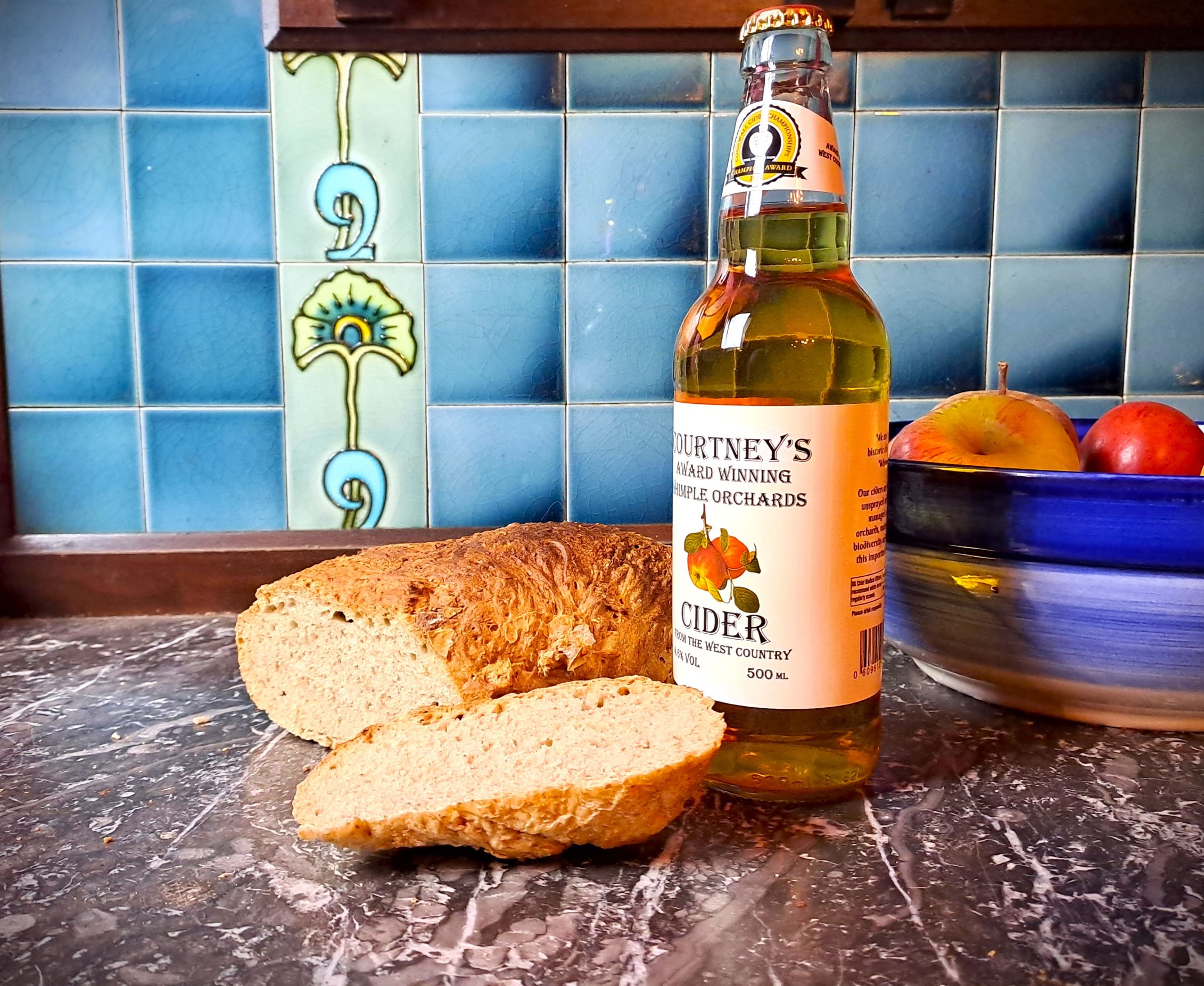
My love affair with this recipe started about a year ago and it has developed into a steady, committed relationship of previously unknown depths. It is quick, low energy (both for you and your bills) and clean, only using one bowl and a spatula (and a bowl to weigh out the flour, but I reuse that to weigh out the dogs’ rice, so choose not to count it).
This was originally a Dutch Oven recipe, which always produced crusty, fabulous loaves, but also mean my oven was on at 240°C for 1½ hours and recently I decided… not to do that. So, we were missing out on lovely homemade bread.
Fortunately, I gave into the craze and got myself an air fryer, became dutifully obsessed and one day, while extoling the virtues of this heavenly contraption, I decided to test its limits with this bread. Sorting out the timings was a bit hit and miss, but this recipe is nothing if not forgiving and I quickly hit on this winning recipe for success.
The recipe itself is very simple: yeast, sugar, water, cider, flour and salt. If you stick to the ratios and methodology, it is an extremely flexible recipe, so you can adapt it to your taste. My family likes brown bread, so I personally split my flour between strong white and wholemeal bread flours and that works very well, although it does produce a denser loaf than when I use just strong white bread flour. You can add any herbs and spices you feel like to make it your own.
Cider adds a fantastic flavour to the bread, making it ever so slightly sweeter and much more interesting. So far I’ve stuck with the classics, but I wonder what would happen if you used Mixed Berries Frapple…
Recipe
- 200ml Courtney’s Cider
- 100ml hot water
- 11g dry active yeast (1½ packets)
- 1tsp sugar
- 400g bread flour
- 1 large pinch salt
- Mix the dry active yeast and sugar together in a large bowl.
- Pour over the Courtney’s Cider and hot water and wait for the yeast to activate.
- Mix together the flour and salt. If the salt comes into direct contact with the yeast, it will kill the yeast and your bread won’t rise.
- When the yeast has frothed (about 5-10 minutes, but wait for longer if it’s cold) tip your flour and salt mixture into the liquid and mix with a spatula until the ingredients are combined and no flour is visible on the surface of the dough.
- Cover and leave in a warm place to proof. If it’s warm, the dough should double in size in an hour, but if it’s cold either wait it out, or take the opportunity to turn a radiator on for an hour with double the purpose.
- When the dough has doubled in size, take the spatula and fold the edges into the middle of the dough, moving in a circular motion, until the dough is retaining its shape.
- Recover and leave to proof for 40 minutes.
- Preheat the air fryer to 205°C.
- When the air fryer is heated, place a piece of baking paper on the bottom of the basket and easy the dough onto the paper using a spatula. The dough is loose and will not hold its shape. Try not to lose any air bubbles during the transfer.
- Set the air fryer to 25 minutes and walk away.
- Check and either take it out, or add another 2 minutes, if you feel the bread isn’t quite baked.
- Let the bread cool before serving, or it will crumble.
Serving Suggestions
Add garlic powder to your flour mix and make a garlic butter to dip the bread into. From experience, this will make any dinner party guest ask for the recipe at the first bite. Serve with Whimple Orchards Cider.
https://courtneys.online/cider/whimple-orchards/
Stuffed Acorn Squash
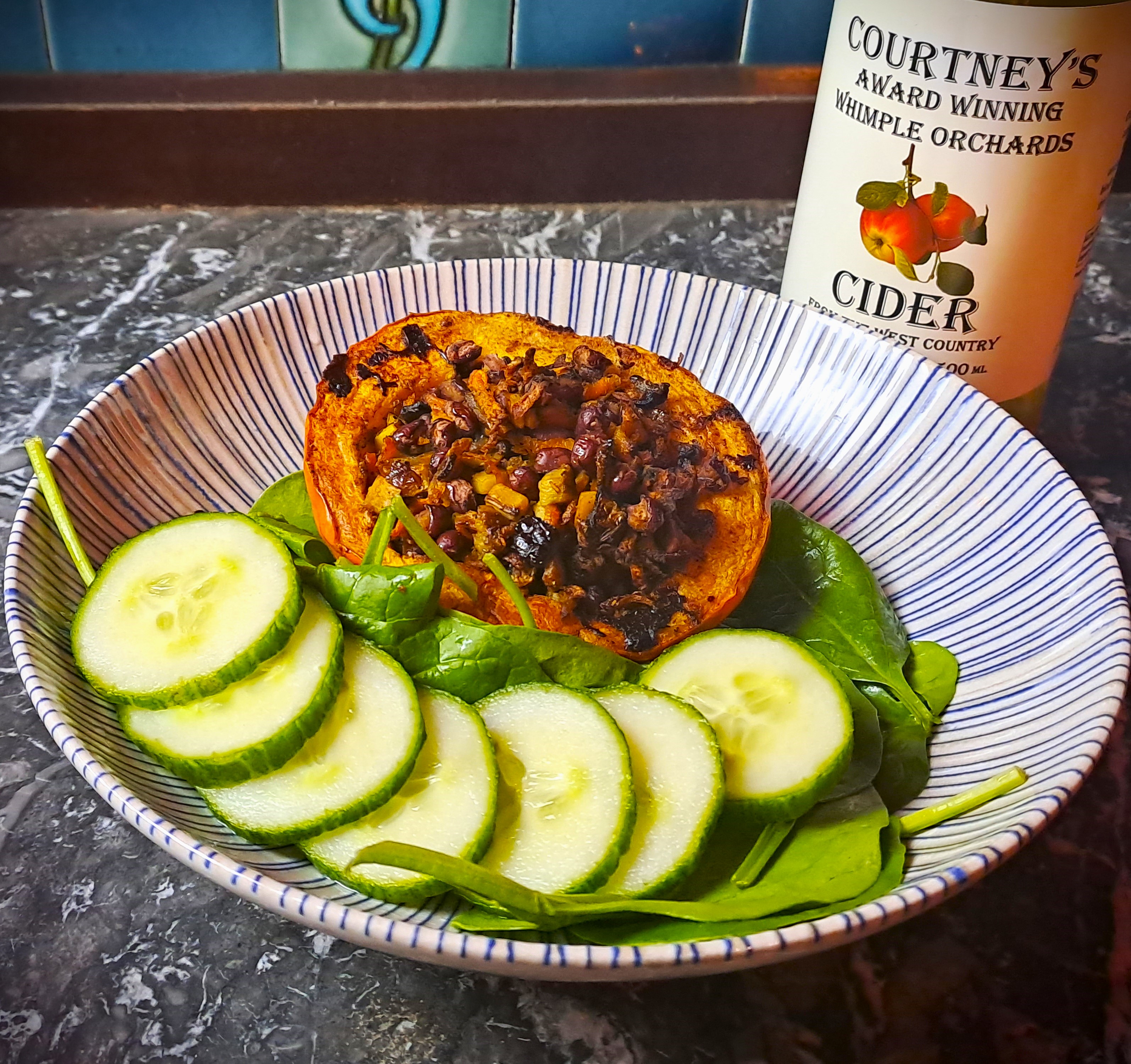
When I cut open an acorn squash, I am immediately struck by the colours and smells of autumn. Bright orange, rich and earthy. It’s like a walk in the woods just when the leaves are beginning to turn. This recipe is perfect to make after a long autumn walk as well. It warms you through and leaves you feeling full and light at the same time - a healthy comfort food.
The other lovely thing is that after you have rubbed the squash with the oil and spices, your hands smell like ginger biscuits for hours afterwards and isn’t that the best smell in the world?
The filling can be whatever you want it to be, but this is the mixture that I personally love. Adzuki beans are one of my favourites when the weather turns, again because of the earthy, filling flavours (so a leftover half tin will get used up very quickly) and you can’t go wrong with onion, garlic and mushroom. The pepper prevents the mixture from becoming a bit dry, which can happen and freshens the mix. The apple and carrot are a lovely addition, especially if you want to emphasise the sweetness of the squash, but they are not essential.
The spice mix I’ve listed below is my personal favourite. I found it in The Forme of Cury, a recipe book from the 14th century. It is called Poudre Forte, or strong powder, a blend of cinnamon, ginger and white pepper, in whatever ratio you prefer. I find a ratio of 2:2:1 works best. I always have a big jar of it on hand, because it seems to go with everything, but you can make it for a single meal, I suppose…
The Recipe:
- 1 Acorn Squash
- 1 Tsp oil of choice
- 1 pinch of salt
- Spice mixture: 1 tsp powdered ginger; 1 tsp powdered cinnamon; ½ tsp white pepper
- ½ can Adzuki Beans (well drained)
- ½ Onion (diced)
- 2 cloves Garlic (minced)
- 2 Chestnut mushrooms (finely diced)
- ½ Bell Pepper (finely diced)
- 1 Carrot (grated)
- 1 Apple (finely diced) (optional)
- ½ tsp thyme
- Cut the acorn squash in half and scoop out the seeds and guts.
- Brush the exposed flesh with oil and seasoning and place on baking tray. Roast at 190°C for 45 minutes, until the flesh is easily pierced by a fork (if you are using an air fryer, then 12 minutes at 200°C works)
- While the squash is roasting, fry the onions over a medium heat. When the onions are softened, add the mushrooms, apple and garlic. Season with salt, thyme and a tsp of the spice mixture. When the mushrooms are fully cooked, add the carrot and bell pepper and cook for another minute.
- Remove the squash from the oven and spoon the filling into the hollows. If there is filling left (there probably will be) don’t worry, as it is fantastic reheated with rice.
- You can serve it at this point, or return it to the oven to crisp. In the oven, at 180°C for 10-15 minutes. In the air fryer, at 180°C for 5-7 minutes.
- Serve with salad.
Serving Suggestions
Pairs well with Whimple Orchards Cider
Available here: https://courtneys.online/cider...
Zero waste tips
Seeds: wash them; toss in olive oil, garlic, paprika and salt and roast at 180°C for 12-15 minutes. It’s a healthy snack, or great addition to soup.
‘Guts’:
- Add to stock. Pumpkin guts will sweeten your stock and make it naturally thicker. Remember you have added it, or you might get surprised by the different consistency (I speak from experience)
- Boil it thoroughly, strain and add it to your dog’s food. They will love you forever. It’s also good for them, but mainly the loving you thing.
- Face mask: boil the guts until soft and strain them. Blend the cooked guts with 1 tbsp olive oil. Spread on your face and leave for 20 minutes. It’s really good for dry skin.
- Juice: Pour boiling water over the guts to soften them. Remove from the water, mash them up with a form and put through a strainer. Add the resulting juice to other juices or smoothies.
- Compost. Make sure the seeds are removed, or you will end up with lots of pumpkin plants in your compost.
Skin
- Give them to your dustbin-dog (mine did not give me a choice. He might love squash skins more than he loves me)
- Compost
- Pumpkin chips: I have never done this, but apparently if you put cooked pumpkin skin coated with olive oil, cinnamon and nutmeg in the air fryer for 8 minutes at 195°C they are very nice. Aforementioned dustbin-dog has prevented me from ever trying this out.









